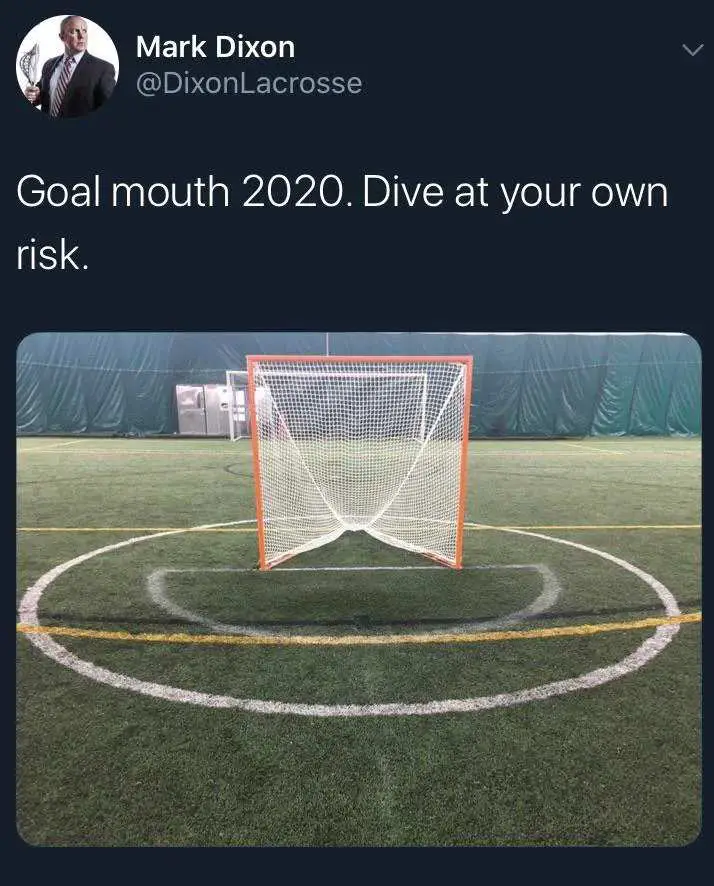Among the many things lacrosse players need to take notice of, the crease is definitely a term they should not ignore. It has an impact on the most important part of the game which is scoring a goal. So every player on the team must be very familiar with what the crease means and the rules around it.
There have been some new rule changes on the crease, so we will also go over them to make sure you aren’t confused. And first thing first, let’s define what and where the crease is.
The goalie crease is the circle that surrounds the lacrosse goal on both sides of the field. The circle has a 9ft radius to depict the goalie’s area. Inside the circular lining, the area is goalie only. Offensive players must not step into the crease regardless of the situation. In 2021, NCAA added a 2-inch-wide line that forms a half circle with a 6-foot radius inside the 9-foot goalie crease. This new area is called the goal mouth, which we will also get into later.
Read also: What does hot mean in lacrosse?
What you need to know about the crease

In most cases, casual fans probably don’t even notice this circle surrounding the goal as it doesn’t interfere with watching the game. However, for players, the crease plays an important role. Especially offensive players must keep an eye on the crease.
The reason why the crease is hardly noticeable is that it’s thinly painted onto the field. In particular, if the team uses a multi-purpose field, the crease is oftentimes painted a day or two before the game starts. Also, nothing else inside the crease is painted although NCAA changed that in 2021 by adding a goal mouth.
Who can enter the crease?
The only player who is allowed inside the crease with possession is the goalie. Since it’s the goalie’s job to defend the goal by blocking opponents’ shots, this area is the perfect spot for them to situate in. One thing to note is defensive players on the same team are allowed to step inside the crease as long as they don’t have the ball.
Offensive players are forbidden from ever stepping foot into the crease unless it’s a crease dive. For this reason, once the offensive player enters the restraining box, besides keeping an eye on the shot clock, they also need to make sure they are aware of the crease to avoid penalties.
What’s the goal mouth?
As aforementioned, the goal mouth is an arc that extends 6 feet from the center of the goal line to the goal lines extended. This new arc was added by the NCAA committee to address concerns raised by players and coaches about dive players in games.

Offensive players are prohibited from jumping or diving then consequently landing inside the goal mouth. Any physical contact with the goalie inside the goal mouth will result in no goal and a one-minute penalty. Landing in the goal mouth without contacting the goalie will result in no goal and loss of possession.
Therefore, offensive players must not enter the goal mouth in any event. The field marking may be placed on the field with paint or chalk.
Read also: Best Attack Heads in 2022
What you need to know about the crease rules
Now we have a basic understanding of the crease. Let’s move on to discussing a couple of rules you should know in order to avoid getting unnecessary fouls.
Crease Shots
There are always exceptions and unique situations that can be applied to most lacrosse rules. And this is true for crease shots as well. The area around the crease can get very chaotic so referees must evaluate each situation on a standalone basis.

There’s one common exception if the momentum of a shooter carries them into the crease after the ball has entered the goal, the goal counts. Which means if the shooter lands inside the crease before the ball has entered the goal, the goal doesn’t count. What makes this a legal shot is for two reasons. One is the lack of intent to collide with the goalie. Another is the ball must enter the goal first.
In most other situations, offensive players must not touch or enter into the crease line for the goal to count.
Crease Dive
Crease diving is one of the most exciting ways to score. At the professional level of lacrosse, players are allowed to crease dive. Yet college lacrosse has gone back and forth on the legality of this type of scoring. One side of the table argues for safety reasons and the need to be consistent with the crease rules. The other side of the table defends the action as the player doesn’t touch the crease before the ball is inside the goal.
After a series of discussions, NCAA men’s lacrosse reinstated the legality of crease diving. Here’s the latest version of the crease rules players must know:
“If an offensive player, in possession of the ball and outside the crease area, dives or jumps in a direction away from the goal mouth and lands in the crease outside the goal mouth, the goal shall be allowed. Provided the ball enters the goal before contact with the crease, goaltender or the goal.
If an offensive player, in possession of the ball and outside the crease area, dives or jumps in a direction that is not away from the goal mouth and lands in the goal mouth, the goal shall be disallowed.
In addition, the player shall be penalized with a 1-minute foul should the offensive player initiate contact with the goalkeeper within the goal mouth. Landing in the goal mouth without contact with the goalkeeper shall result in a loss of possession.” (Source)

Thus, the TLDR version of the rule is that the offensive player must dive or jump away from the goal mouth. In the event of directing momentum toward the goal mouth, the shooter will be penalized with a 1-minute foul.
Goalie Limited Possession Time
Because the goalie has absolute power inside the crease, to avoid the goalie exploiting their power, there’s a set amount of time the goalie has when retaining possession in the area. It’s called a four-second rule.
The goalie must clear the possession or leave the crease no longer than four seconds within the crease. If they remain in the crease longer than four seconds, possession will be forfeited to the other team. Moreover, once they left the crease after the four seconds expired, the goalie cannot re-enter to remain in possession. Therefore, goalies must be aware of this time limit once they block a shot and get hold of the ball. So it’s best to clear it right away without wasting any time.
Goalie Interference
There’s another special rule in regards to the crease offensive players and goalies need to be aware of. As long as the goalie has both feet within the crease and extends their stick to scoop up a ground ball, opponents are not allowed to interfere.
The rationale is the goalie’s body is still within the crease even if their stick is outside. So the goalie can scoop up the ground ball and bring back the stick inside the circle lining. If offensive players attempt to make contact with the goalie, there could be a potential foul given.
Read also: Can your hand touch the ball during a game
Why the crease is important
Now you understand what the crease is and what the rules are. To bring this discussion home, it’s time to explain why the crease is important so that you truly understand its meaning in lacrosse.
For the safety of the goalie
Being a goalie is a tough job, to say the least. They are constantly at the risk of being hit by fast and aggressive shots. Apart from wearing minimal protection gear, goalies really don’t have much to protect themselves.
For this reason, the crease is implemented to create a safe space for goalies to keep shooters away from brutal forcing into the goal. It’s extremely dangerous when players collide with each other at a great speed, so the implementation of the crease is definitely necessary.
In other words, the crease creates some extra cushion for the goalie to alleviate the force of lacrosse shots that can travel up to 90 miles per hour.

Balancing between offense and defense
Another key to understanding the crease has to do with keeping a fine balance between offense and defense. Without an area like the crease, offensive players have nothing to stop them from going all the way to the front of the goal to shoot. They could just force their way into the goal every time.
This is, first of all, very dangerous since players will be swamping the center lane in front of the goal. There will be a very high likelihood of severe clashes and collisions. Second of all, this will tilt the pendulum toward the offensive team in a significant way. Which is the primary concern the lacrosse community tries to avoid and improve upon.
Hence, the creation of the crease not only fulfills the idea of preserving the game’s dynamic but also prompts players to utilize strategies and techniques to win games.
Conclusion
I hope after reading this post, you now can look at the crease in a completely different light. This thinly painted circle has many nuances and exceptions you definitely need to be aware of. Whether you are a beginner or an experienced player, the crease will continue to play an important role in your career.
Read also: What to wear to lacrosse practice




